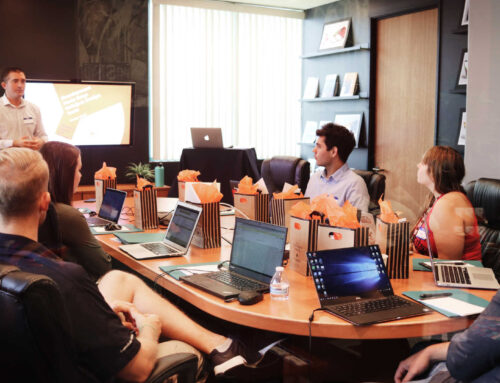Transcript
Hi, everyone, I’m Arun from Funnel Envy.
We help demand gen marketers increase pipeline and revenue through revenue funnel optimization.
And today I want to talk about why you should really focus on the offers. I’ll explain what that means as we go through this.
Now, let’s take a step inside the data driven demand generation marketing team, maybe the top problem on the CMOS radar is that the acquisition costs are too high and they’re not going to hit their pipeline or revenue goals. And so she’s asking that the head of demand gen, you know, where’s the problem?
Now, looking at the data, being a good data driven marketer he comes back with, you know, they’re spending a lot of money on unpaid and organic traffic. The quality of that traffic is good, but it’s just not converting like it should be.
So, of course, the natural question is, what can we do about it?
Now very good answer and a common answer is to focus on website conversion rate optimization. And that typically involves running a lot of online experiments.
So you can budget that, make it a priority but recognize that those executives are probably going to want to see impact based on pipeline and revenue and probably want to see it fast.
So let’s dig into online experimentation, back in twenty seventeen the Harvard Business Review published this important study and article really talking about the power of online experimentation and correlating successful business outcomes to a culture of experimentation. They cited examples like this from Bing where bing tested multiple different colors on their site, ran experiments and realized an incremental 10 million dollars in annual revenue from these experiments.
Similarly, Google ran a test with 40 different shades of blue on their site, when they ran those experiments, they saw 200 million in incremental revenue. And given these results, should we as demand gen marketers be running the same kind of experiments?
Well, in our opinion and in our experience, no. You’re not Google or Bing, leaving aside traffic considerations, you’re trying to influence B2B buyer behavior over a long customer journey. And the reality is that groups of buyers that are considering enterprise solutions are not going to be influenced to buy based on the button color or other small cosmetic changes. And this is really important because, of course, experimentation comes with a cost. Not only do you have the people and the technology costs of running online experiments, it’s also an impact on your ability to make decisions as an organization. So, it’s really important that when you’re doing this, you focus on the elements that are actually going to deliver revenue and influence those B2B buyers.
Now, when we think about the B2B buying journey or the revenue funnel, you can think about it as various stages and as prospects progress through those stages, they do so through a series of exchanges. This is fundamentally the heart of marketing where you are offering something to that prospect in exchange for something else that could be a piece of content in exchange for their attention or their contact information, that could be an offer to attend an event, that could be an offer to talk to the sales team, it’s some offer through which they learn more about how your solution is going to benefit them.
So from our experience and in all of the testing that we’ve done, the highest value, the highest leverage use of experimentation for the demand gen org is to improve the relevance of those offers through that revenue funnel, through that buying journey and the ease of engaging with it. And of course, we always want to make sure we’re measuring the impact of those experiments based on the KPIs that matter, pipeline and revenue.
So what does it mean to be optimizing offers? Well, we like to focus on three main aspects.
One, of course, is the offer itself, that thing that you’re proposing to exchange with that visitor or prospect for them to better understand your solution. The more relevant it is to that visitor and their intent, the more effective your ability to convert them will be.
The other important aspect of the offer is the framing of the offer, and here we’re really talking about the headlines and CTA’s headline is really important because typically a visitor is going to spend five or 10 seconds, at the most, deciding if they want to stay on your site or hit the back button and go somewhere else. So the more effectively you can position that headline and entice them to continue reading and engaging with it, the more effective you’re going to be.
Third element of the offer is the mechanism of exchange, how they actually exchange what you want from them in exchange for the offer that you are putting in front of them. Typically, this is in the form of a web form, but it doesn’t have to be. We’re also seeing more chat bots, conversational marketing tools that accomplish the same thing, provide that medium of exchange for the offer.
So let’s look at some examples.
Landing pages are a great starting point. Many of you are probably running traffic to landing pages and putting an offer in front of those visitors hitting it. Now, in this case, we recognize working with a customer that they actually had three viable offers for those visitors coming through their paid campaigns to their landing pages. And rather than only showing them one, we use data to dynamically personalize the offer itself, but also the framing and the page layout to reflect what might be most relevant to that visitor. And doing this, we see an almost 44 percent improvement in revenue per visitor when we ran this experiment.
We spend a lot of time working on the home page and specifically that above the fold section of the homepage, at the top of the page where most of the eyeballs go. Now, many of you might have a site and a home page that kind of looks like the baseline experience here where you’re trying to introduce your solution at the very highest level to that first time visitor. But of course, you probably have a lot of return visitors, especially if you’re a SAAS solution, a lot of return visitors who are already familiar with your solution or your offering. And it probably doesn’t make sense to show them that same welcome offer. And in this case, we actually were able to identify visitors and the specific solutions that they were interested in and present that offer right on the home page that otherwise would have been further down in the in the website that they would have had to navigate to. So I presented them with an offer that they were more interested in and serving those as variations right on the homepage, we see an almost 50 five percent improvement in conversions coming through this page.
Now, you can do this based on buyer stage as well, in this example, we have a customer with a freemium model where visitors who are on the free plan come to the home page and see a call to action or a button that says upgrade your plan. When they click on it, the baseline experience was to take them to standard SAAS Plan tiers and they could select the one that they would upgrade to.
Now, using data, what we were able to do is identify the plan, which was most relevant for any individual visitor, and show them instead of a plan selection, show them the specific plan that they should upgrade to right on that home page, as well as the benefits they would get out of that plan. CTA was changed to from upgrade your plan to upgrade to a specific plan at a specific price point. And in doing this, we’re able to bypass the plan selection, kind of choose your own adventure experience and take them directly to the credit card entry and upgrade.
So by removing friction, presenting them with a more relevant offer, we’re able to see and almost 70 percent improvement in revenue per visitor coming through this experience.
Of course, that mechanism of exchange is often the form, and so we spend a lot of time optimizing forms. Now recognize there’s often a lot of friction on behalf of the visitor when they see a form and they start to enter personal information, even if they’re interested in the offer. The act of giving someone your email and other personal information often presents a big hurdle. And this is where you see a lot of drop off in terms of conversion. So one of the things that we like to do is take those contact forms and reinforce the benefit and the value to the visitor of filling out that form.
So you can see an example of that where we take a default contact form, which is kind of generic and make it very focused on the benefits and ran this experiment. Here we see about an 85 percent improvement in conversions coming through this form.
Final example, you know, if you have the data, you can get pretty sophisticated with this. Many times we see experiences like the baseline product homepage that you see here where it’s a solution that actually speaks to multiple personas within the organization. And your team actually has different offers for each of those personas.
Now, when you try to put it on a single page, they all compete for attention and kind of blend in and none of them gets the conversions or attention that they deserve. By using data, we were able to identify the offer that was most relevant to the specific visitor or persona coming to this page and replace that experience with multiple calls to action with a single focused offer that was most relevant to that persona, in this case, a developer or an analyst or a manager. Here running this experiment with those variations we see in almost 50 percent improvement in revenue per visitor.
So the offers are really important to focus on as the highest leverage area of experimentation for the Demand gen marketer on your site.
And I want to wrap up with some final points.
It’s really important before you undertake this kind of experimentation to make sure you have solid revenue insights. What that means is make sure you’re able to evaluate your existing offers based on their pipeline and revenue contribution and that you’re set up to measure your experiment not just based on onsite conversion, but based on their impact to pipeline and revenue.
You saw some examples of segmentation that I walked through and personalization.
Our recommendation is to prioritize your segmentation based on how the differentiation of intent across those segments and the size of your addressable audience. We often find that people are running segmentation only for like five or 10 percent of their audience. That’s not going to be as effective as if you can address 90, 95 percent of the visitors coming to your site. This is why we start with buyer stages as our starting point for segmentation, because it presents both great opportunities for differentiated Intent buyers at different stages, want to see different content and engage in different ways. And it maximizes your addressable audience. The vast majority of the visitors coming to your site fit into anonymous, known lead, active opportunity or customer.
Finally, there are a lot of common sense opportunities if you start thinking about buying stages for more relevant offers and some obvious gaps that you should be able to identify.
Start by asking yourself some simple questions.
Should a known lead see a lead capture form? Does that make any sense or can we repurpose those pixels and that experience for something that’s more relevant?
Similarly, should an existing customer see the requested demo call to action or talk to sales? Maybe not. Maybe there’s an opportunity to up sell them or, you know, get them to support or other resources that may be more relevant.
And with that, I want to thank you for listening today, bye.





